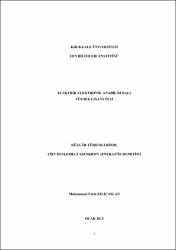| dc.contributor.advisor | Sevinç, Ata | |
| dc.contributor.author | Kılıçaslan, Muhammed Fatih | |
| dc.date.accessioned | 2021-01-16T19:12:22Z | |
| dc.date.available | 2021-01-16T19:12:22Z | |
| dc.date.issued | 2015 | |
| dc.identifier.uri | | |
| dc.identifier.uri | https://hdl.handle.net/20.500.12587/16758 | |
| dc.description | YÖK Tez ID: 418461 | en_US |
| dc.description.abstract | Rüzgâr enerji sistemleri için çift beslemeli asenkron jeneratör, çeşitli rüzgâr rejimlerine ve şebeke hatalarına etkin cevap verebilmesi nedeniyle oldukça avantajlı bir seçenektir. Ancak karmaşık modeli ve çok sayıda parametreye sahip olması nedeniyle kontrol edilmesi oldukça zordur. Tezde, kontrolde kullanılan temel bazı yöntemler ve ara işlemler anlatılmıştır. Sonra çift beslemeli asenkron jeneratör kontrolünde kullanılan belli başlı yöntemlerden bahsedilmiştir. Kullanılan çoğu yöntemde çift beslemeli asenkron jeneratörün statoru doğrudan şebekeye bağlı olup, kontrol girişleri rotordan bir konvertör aracılığıyla uygulanır. Bu tezde de bu yapı kullanılmış, ancak yaygın olarak kullanılan alan yönlendirmeli kontrolden oldukça farklı birkontrol yöntemi önerilmiştir. Burada farklı olarak tork ile stator akısı tam olarak ayrıştırılmış biçimde kontrol edilmektedir. Ayrıca rüzgâr için bir modelleme kabul edilip, rüzgâr parametreleri en küçük kareler yöntemiyle tahmin edilmiştir. Yöntemin esasları açıklanmış ve kullanılan çift beslemeli asenkron jeneratör modeline simülasyon olarak uygulanmıştır. Çift beslemeli asenkron jeneratörün sürekli ve kesikli rüzgâr rejimi durumlarında kontrolü sağlanmış, rüzgâr kesildiğinde uygulanabilecek en verimli devreden çıkarma seçeneği araştırılmıştır. Bu bağlamda 3 farklı durum simülasyon sonuçlarıyla açıklanmış ve aralarında kıyas yapılmıştır. Rüzgârın sergilediği karakteristiğe bağlı olarak hangisini kullanılabileceğine dair önerilerde bulunulmuştur. Son olarak tezde uygulanan yöntemin MATLAB kodları konuyla ilgilenen araştırmacılara faydalı olması adına ekte sunulmuştur. | en_US |
| dc.description.abstract | The doubly fed ınduction generators are very adventegous choice for the wind energy systems becuase of responding for various wind regimes and grid faults effectively. However, its control is quite hard because of its comlex model and the high number of the parameters in the structure. In this thesis, some basic methods used in control and intermediate computations are explained. Then, prominent methods are mentioned used in control of doubly fed ınduction generators. In most of the control methods, the stator is directly connected to the grid and control inputs are applied from the rotor through a converter. This structure has also been used in this thesis but a control method which is quite different from widely used field oriented control has been suggested. As a difference, the torque and stator flux are controlled as completely decoupled. In addition, a wind model is assumed and its parameters have been estimated with the least squares method. Basics of the method have been explained and simulated on the useddoubly fed ınduction generator model. The control of doubly fed ınduction generators is provided in continious and discontinious wind regimes. The most efficient turn-off choice has been studied in no wind case. In this context three different modes have been explained with their simulation results and compared. According to the characteristics of the wind, some suggestions are given about which one should be used. Lastly in this thesis, the MATLAB codes of the method used in this thesis are attached to be helpful for researchers. | en_US |
| dc.language.iso | tur | en_US |
| dc.publisher | Kırıkkale Üniversitesi | en_US |
| dc.rights | info:eu-repo/semantics/openAccess | en_US |
| dc.subject | Elektrik ve Elektronik Mühendisliği | en_US |
| dc.subject | Electrical and Electronics Engineering | en_US |
| dc.subject | | en_US |
| dc.subject | | en_US |
| dc.subject | | en_US |
| dc.subject | | en_US |
| dc.subject | | en_US |
| dc.subject | | en_US |
| dc.subject | | en_US |
| dc.subject | | en_US |
| dc.subject | | en_US |
| dc.subject | | en_US |
| dc.subject | | en_US |
| dc.title | Rüzgar türbinlerinde çift beslemeli asenkron jeneratör denetimi | en_US |
| dc.title.alternative | Doubly fed induction generator control in wind turbines | en_US |
| dc.type | masterThesis | en_US |
| dc.contributor.department | KKÜ, Fen Bilimleri Enstitüsü, Elektrik-Elektronik Mühendisliği Anabilim Dalı | en_US |
| dc.identifier.startpage | 1 | en_US |
| dc.identifier.endpage | 109 | en_US |
| dc.relation.publicationcategory | Tez | en_US |
















